Mac's Believe It Or Not!
by John McDougald
Reprinted from "Crown Jewels of the Wire", May 2000, page 23
New Finds and Old Stories
One of the blessings of being in the business of trying to keep up with all
the known listings of insulators is the number of contacts that are generated
through the magazine, the mail and now the electronic media from collectors who
have made a "new find." When a question about a new find is directed
to me, it is usually designated as a new find because it isn't in the latest
Price Guide for Insulators published in 1999. Questions of this nature generally
fall into two major categories.
New Finds - The first is what I will call embossing variations. Often the
question will be similar to the following: "In the price guide, your
listing [040] has a period between the 'T' and the 'D', but I have one with
exactly the same embossing but there isn't any period." I reply and explain
that punctuation was a problem from the beginning of trying to record all of the
embossings, and that if a number of different punctuation variations exist, and
that is the only difference, that I usually let one listing represent all of the
possibilities. I appreciate receiving this information, and I do keep a record
of it, but these calls usually don't result in a new listing. Most of the time
collectors understand, but occasionally a collector will be disappointed that
their "new find" isn't a rare jewel.
The second type of question falls
into the "new find" and "new listing" category. This occurs
when a listing is sufficiently different from any prior reported embossing, and
I feel it deserves its own place in the price guide. Two of these types have come
to my attention in the past month, and I thought I would share them with you. I received an E-mail from Daryl
Stahler last month describing a CD 145 Brookfield that I thought was intriguing.
He described a crown embossed piece, embossing [070], the FAB date error, but he
said that Brookfield was spelled "BROOKFIELI", with no sign of the
rest of the 'D' on the end. I'm generally not a big fan of new listings for
partial letters, but he convinced me that I ought to look at it, and so I asked
him to send me the piece.
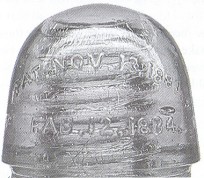
FAB error in second patent
date on CD 1 45 Brookfield
It arrived a week later, and you can be the judge. I
find absolutely no trace of the rest of the final 'D', so it will be recorded for
inclusion in future reference books. Two possible explanations for the error:
(1) the engraver made the vertical cut for the 'D', took his lunch break and
just started on the next line when he came back, or (2) this was a special order
piece for the Italian branch of the Brookfield family, (pronounced Brook-feel-ie).
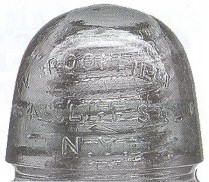
The Brookfield side of the
insulator is embossed
strongly and clearly. . .
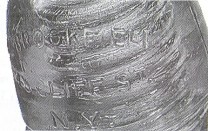
BROOKFIELI
The second new listing brought back some frightening memories of one of the
worst pricing mistakes I made in the 1991 version of the price guide. Back in
1991, I was looking over listings for CD 162 Hemingrays, and I came across
embossing [260], (F-Skirt) HEMINGRAY/PATENTED (R-Skirt) PETTICOAT. Now I had
seen a lot of these in various shades of light blue, but I hadn't recalled ever
seeing one in aqua. I was only able to confirm one Hemingray signal collector
who had an aqua one in his collection. I had never owned one, and so I concluded
that they must be rather uncommon. I priced the piece at $50. Well, wherever
those pieces had been hiding, they decided to make an appearance within about
two months after the price guide came out. Every ad that came into Crown Jewels
of the Wire and virtually every sales table at every show I attended had one or
more of these listed/available, and guess what the price was - $50. Even now,
when I've trimmed the price to $15-$20 in the current price guide (probably
still too high based on availability and demand), I cringe every time I find one
in a junk box for $1 or less. Everybody's entitled to at least one mistake,
right???
Anyway, back to the new listing. Mrs. Mac and I had a chance to buy a
nice collection this spring while vacationing out west. Since time was short, and the collection was large, we had to separate insulators into three
categories: (1) the ones to be mailed home, (2) the ones to be hauled to Arizona
and stored until our next trip west, and (3) the ones to be donated to a local
collector. This required careful inspection of each piece for unusual features.
I picked up the CD 162 pictured below. It was in a nice bright blue-aqua,
not quite Hemingray blue, but clearly a "Hemingray color". I was
immediately interested because I didn't remember ever seeing a CD 162 Hemingray
insulator with no embossing on one side. I anxiously turned it around, and below
is what I saw on the other side - HEMINGRAY-19.
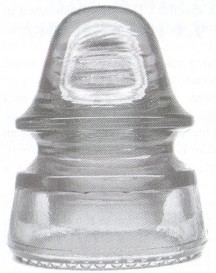
Definitely a Hemingray color and
manufactured CD style...
but, no embossing
My memory was correct (for a change). I had no record of
a CD 162 Hemingray with no embossing on one side. With several dedicated
Hemingray specialists providing me with regular embossing updates, it continues
to amaze me that a listing like this one hadn't been reported. It's reassuring
to know that there are still little gems out there to be found. But this time,
I'm being careful - I'm announcing the embossing to the hobby so that I can get
some feedback before I assign a price and embarrass myself again.
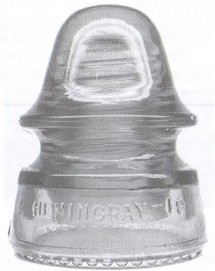
. . . except for
HEMINGRAY - 19
on the front skirt.
Old Stories - For some time, I have been considering starting a series of
short articles dedicated to individual threaded glass CD styles. My concept is
not to make these articles definitive research articles, but rather to capture
some anecdotal information about particular CD's and why they have been
important to individual collectors. I have been thinking back over the past 30
years about all of the collectors I have visited, all the shows I have been to,
and all of the insulators that I have bought and sold. Almost without exception, if a specific CD style is mentioned in
conversation, I can think of at least one story, and often many, regarding
individual collectors and collections related to that CD. I'm sure many of you
have similar memories. Collectors have long talked about the fact that as the
'old guard' becomes less active in the hobby, many of the early history of
collecting insulators will be lost or forgotten. I would like to view this as a
vehicle for capturing at least a part of that history. So I encourage you to
become a contributor to this series. Don't feel as though you have to
"write an article." Just drop me a note, call or send an E-mail with
any information of this nature that you would like to share with the rest of the
hobby. I'll work it in with the other material I receive, along with my own
stories.
As an example, I thought I would mention two specific memories about CD
100, the Surge electric fence insulator. (I do not plan to run the CD's in
consecutive order, so don't worry if you have a story about CD 331, you won't
have to wait until 2009 to see it in print.) The first memory has to do with
embossing errors. These insulators were manufactured by Hemingray in the 1940's
and 1950's when embossing errors should have been a thing of the past. And yet
in this one style, two of the three known embossings are mistakes. The correct
front and rear embossings are shown in the first set of pictures, and the errors
are shown in the second set of pictures.
Embossing [010] is correct, [020] has
the error on both the front and rear, and [030] has only the rear error. I was
very early in my collecting days
Front skirt: Embossing [01 OJ Rear skirt: Embossing [01 OJ
when a dealer
pointed out the spelling error on a CD 100 Surge and "how rare" it
was. My only reference point was to stamps with engraving errors, and I was sure this would be a good investment. Now the only thing I am sure of is
that I paid way too much for the first embossing error for my collection.
|
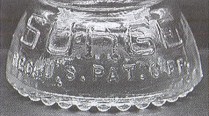
Front skirt: Embossing [010]
|
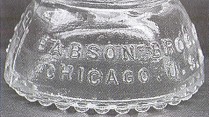
Rear skirt: Embossing [010]
|
|
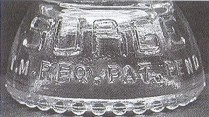
Front skirt: Embossing [020]
|
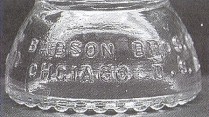
Rear skirt: Embossing [020]
Rear skirt: Embossing [030]
|
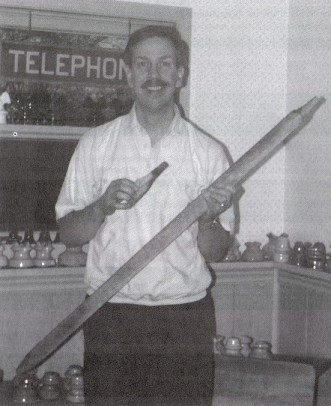
Believe it or not, I have owned many of the oak sidepins used on Surge
installations, but never one of the long post pins. A small quantity showed up
in an Illinois antique store during the past year and Russ Frank of the GCIC
purchased one for his collection. He then told fellow club member, Rick Soller,
about his find, and Rick went to the store and purchased all that they had. When
they were placed on Rick's sales table, I was fortunate enough to have a chance
to purchase one.
My
second memory has to do with one of the real founders of the hobby. Along with
Woody Woodward and Dora Harned, Marion Milholland did as much as anyone to advance the insulator hobby in its early years. I only had
the pleasure of meeting him twice: first at one of Larry Veneziano's Chicago
Jumbo shows and again at one of the early London, Ohio shows hosted by Steve and
Lois Blair. I don't remember Marion carrying much to sell or trade because he
was usually too busy meeting collectors and recording information in his
notebook for inclusion in a future publication. But if you check back through
the Crown Jewels of the Wire from the early 70's, you will find an occasional
listing in the advertising section by Marion Milholland, selling CD 100 Surges,
not individually, but 36 at a time "in thy original packing box." They
were neat boxes, one layer, and 36 Surge insulators were laid out in six rows of
six each. Mrs. Mac and I bought one box ($20 including shipping) when $20 was
about a half-a-day's pay. We weren't sure we had made a wise investment at the
time, but when you could buy any insulator for $.50 and sell it for $1.00 we
figured we could get our money back eventually. I know Marion sold dozens, maybe
hundreds, of boxes of Surges in the early 70's. I wonder how many collectors
still have those boxes? I wish I did, but I think it went out with the trash in
the early 80's. It would have been a nice go-with for the Surge pin and post,
pictured on the previous page -- Believe It or Not!
|
